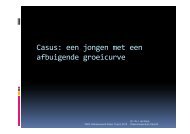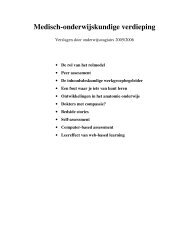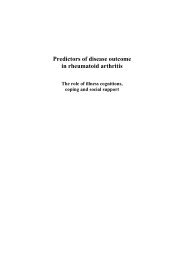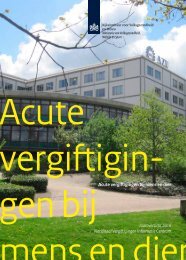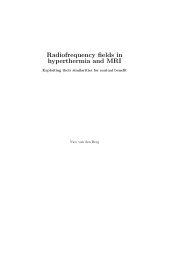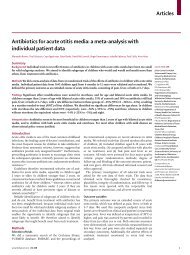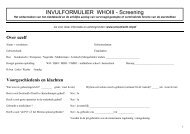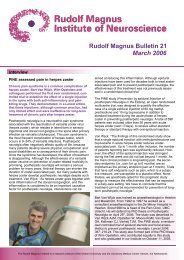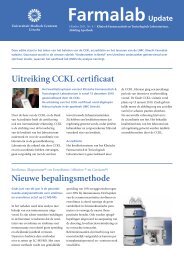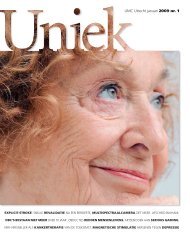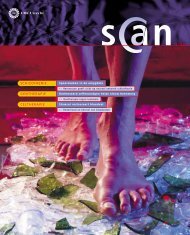Rudolf Magnus Bulletin 29 February 2007 - UMC Utrecht
Rudolf Magnus Bulletin 29 February 2007 - UMC Utrecht
Rudolf Magnus Bulletin 29 February 2007 - UMC Utrecht
You also want an ePaper? Increase the reach of your titles
YUMPU automatically turns print PDFs into web optimized ePapers that Google loves.
<strong>2007</strong>-03<br />
<strong>February</strong> 6, <strong>2007</strong><br />
Alexander F.J.E. Vrancken<br />
Diagnositc efficiency and treatment strategy in<br />
chronic axonal polyneuropathy<br />
J.H.J. Wokke, N.C. Notermans and H. Franssen<br />
supervisors<br />
Alexander Vrancken started his PhD in September<br />
1997 after he finished his medical training. He is a<br />
resident in the department of Neurology and<br />
Neurosurgery since 2000. He completed his thesis in<br />
the section of Neuromuscular Diseases.<br />
Polyneuropathy is a common peripheral nerve disorder<br />
that often has a well known cause such as diabetes,<br />
chronic renal disease, alcohol abuse, vitamin deficiency,<br />
hypothyroidism, or use of toxic medication. Elderly people<br />
are more often affected, but the differentiation from signs<br />
of normal ageing can be difficult. It is important to<br />
diagnose a polyneuropathy and establish the cause at an<br />
early stage, because treatment can ameliorate symptoms<br />
and prevent progression. Because of the ageing<br />
population, the number of people affected by a<br />
polyneuropathy can be expected to increase. My thesis<br />
deals with questions regarding the efficient work-up and<br />
treatment strategies for chronic axonal polyneuropathy.<br />
A description of the main study results is as follows. In<br />
about 25% of healthy elderly people older than 60 years<br />
the vibration sense at the big toes or ankles and<br />
the ankle jerks can be absent, and this should be taken<br />
into account when developing a clinical diagnostic<br />
definition for polyneuropathy. Implementation of a<br />
restrictive guideline for the workup of polyneuropathy leads<br />
to less diagnostic delay (on average 2 weeks), fewer<br />
investigations and less costs (about 30%), whilst retaining<br />
diagnostic reliability. For chronic axonal polyneuropathy,<br />
the sural and superficial personal SNAP have<br />
complementary diagnostic value and equal diagnostic<br />
accuracy. Neither ageing nor disease duration have an<br />
important influence on the disease course or prognosis of<br />
chronic idiopathic axonal polyneuropathy. Sural nerve<br />
biopsies in progressive idiopathic axonal neuropathy often<br />
demonstrate inflammatory abnormalities suggestive of<br />
vasculitis (i.e. an inflammation of arterial blood vessels),<br />
but the absence of these findings does not preclude an<br />
immune-mediated origin of this neuropathy. Based on a<br />
literature review according to the methods of The<br />
Cochrane Collaboration© there is no evidence from<br />
randomized trials on which to base treatment for chronic<br />
idiopathic axonal polyneuropathy and non-systemic<br />
vasculitic neuropathy.<br />
<strong>2007</strong>-04<br />
<strong>February</strong> 7, <strong>2007</strong><br />
Carien S. de Kloet<br />
Afterwards. Neurobiological alterations in veterans<br />
with and without postraumatic stress disorder<br />
H.G.M. Westenberg, C.J. Heijnen and E. Vermetten<br />
supervisors<br />
Carien de Kloet started her PhD in June 2001 after she<br />
finished her medical training. She works at the<br />
department of Psychiatry and completed her thesis in<br />
the section Psychiatric Phenotypes.<br />
Traumatic experiences can result in long-lasting<br />
psychological dysfunction. Based on epidemiological<br />
studies we can expect that approximately 3% of Dutch<br />
military personnel will develop psychopathology in the<br />
aftermath of their deployment. My thesis focuses on the<br />
alleged hypothalamic-pituitary-adrenal axis (HPA-axis)<br />
dysregulation in posttraumatic stress disorder (PTSD). In<br />
all studies described in my thesis, we included two,<br />
sometimes three groups: Dutch veterans with PTSD,<br />
veteran controls (with the same kind of trauma exposure,<br />
but no symptoms of PTSD or other psychopathology) and<br />
healthy non military controls. This design enabled us to<br />
associate alterations in biological readouts with either<br />
trauma exposure or specific features of PTSD.<br />
The ACTH response to cognitive stress as well as baseline<br />
levels of plasma corticotrophin releasing hormone and<br />
vasopressin were specifically related to the presence of<br />
PTSD. The question remains whether these are<br />
“neurobiological markers” that develop after traumatic<br />
stress in PTSD patients or vulnerability factors that were<br />
already present before deployment.<br />
The response to the dexamethasone suppression test, the<br />
awakening cortisol response and leukocyte glucocorticoid<br />
receptor binding showed differences between veterans<br />
who experienced traumatic stress during their deployment<br />
(both PTSD patients and control veterans) and healthy<br />
controls, and might therefore be related to trauma<br />
exposure or other military related factors.<br />
PTSD patients with a comorbid depressive disorder (MDD)<br />
showed differences in the response to dexamethasone-<br />
CRH challenge and a cognitive challenge compared to<br />
PTSD patients without comorbid MDD. This suggests that<br />
we might be dealing with subtypes of PTSD, characterized<br />
by differences in HPA-axis and Sympathetic Nervous<br />
System regulation.<br />
Follow up studies assessing neurobiological and<br />
psychological parameters in patient control and<br />
prospective designs, hopefully will help to answer the<br />
questions raised in this thesis and will help to understand<br />
why some do and others do not develop mental health<br />
problems in the aftermath of traumatic stress.<br />
secretariat Universiteitsweg 100, 3584 CG <strong>Utrecht</strong>, The Netherlands, m.vandenadort@med.uu.nl, phone +31 30 253 8847



